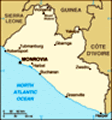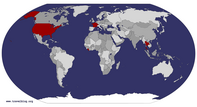Advertisement
Published: July 27th 2012
The lack of blog writing in the last few weeks is indicative of a busy and fun-filled time here in ‘Mama Liberia’ (as many a billboard around here calls it)!
I now write to you from my
third home in country in just seven weeks, in Paynesville, a budding “suburb” of Monrovia. It’s farther from town and work, but the house is nice, the housemates are great, and most of all, I have my own room for free for the remaining weeks that I have left. Things work most of the time, though water pressure and stable voltage remain hot commodities. So much, in fact, that I recently fried my computer charger/adapter because the of the volatile voltage spikes. (Thank goodness there is a strong expat community out here that provide all sorts of extra supplies from Western countries, including spare Apple adapters, or else I would have been done with work here!)
I don’t have much time this time to wax poetic lyrics or write too much (probably to the relief of most of you), but I wanted to share three particularly great experiences and trips
over the last few weeks that will certainly go down as three of my most memorable times in Liberia. Most of all, I wanted to share the photos, so take a look over the next few pages when the text below ends...
A few weekends ago, some new friends and I made the three-hour, bumpy, carsick-inducing drive each way to visit Robertsport for the day, touted as the “surfer beach town” in the northwest corner of Liberia, near Sierra Leone. Now, having lived in a quintessential surfer beach town for years, I can tell you that Robertsport is not it; it is, however, very beautiful and quaint in similarly heartwarming ways. It features several secluded and clean beaches, with endless crabs that dart across the sand like ballerinas on crack, and daily local fisherman that collectively unfold their nets of fresh catch each evening.
We went with a local guy who was born and raised in Robertsport, which was a real treat as he took us to the best local Liberian restaurant with the tastiest cassava greens and dried fish I’ve had in country yet, as
well as to an unexpectedly expansive view from the top of the hill at the town hospital. We trekked across a long peninsula beach that stretched between giant Lake Piso and the Atlantic, to the point where the lake empties into the ocean, and topped off the day with a secluded beach sunset to ourselves. The actual “town” outside of the beaching and fishing action was not much— much smaller and quieter than even Kakata’s streets— but it doesn’t take much to enjoy fresh roasted corn, cute stray dogs, and most of all, giggling children everywhere we go.
Later that week, after a day of work at the government’s philanthropy office, fellow interns and I went up to the
Ducor Palace Hotel. Once Liberia’s finest luxury hotel prior to the civil wars, it is perched atop the highest hill in downtown Monrovia, overlooking the Atlantic Ocean and commanding some of the best, most amazing views of the city, both the affluent neighborhoods of Mamba Point and the urban slums of West Point (yes, I told you everything is named after things in the U.S.). The Ducor was once a shining beacon for the Liberian elite
and Western travelers, and today it is the creepiest, most awesome horror-movie film set I’ve ever seen— a massive abandoned building with sweeping, crumbling staircases, cracked window frames and balcony railings, elevator shafts that fall into a dark abyss, and an empty, oceanview pool that is overgrowing with moss and who knows what else. There is a guard there that you are supposed to pay off to let you in to explore (or just prevent you from going in, depending on how you look and how he’s feeling), but because our driver was from the President’s Office, he let us in and even personally took us around to the best views and nooks, right up to the top floor.
It was fun to see how the various neighborhoods in Monrovia connect to each other, find the helipad-landing site for the U.S. Embassy, and locate the building that we work at in the distance (see photos). I was also surprised to see how many blatant remnants around the city remain from the wars. On the ground, you almost don’t notice as much— you are so busy staring at the ground to avoid stepping into
open sewer manholes (which is a common cause of broken ankles and other bones, apparently) or watching traffic for your half-second chance to dart across the street, that you don’t realize the building above you is a burnt, hollowed-out concrete frame of what used to be one of the major political party headquarters. From the Ducor, these points in the city become much clearer.
But, I was most in awe of the views of West Point and Monrovia’s Freeport— crowded slums and industrial chaos, cradled by literally one of the most sparkling, gorgeous natural settings I’ve ever seen— a crescent-shaped beach that gives way to slow lapping waves and a sandbar that will allow you to walk across the ocean water to an island across the way when the tide is low.
(See panoramic photo at the top of this blog.) Knowing fully well that real estate like this in most places in the world would be dominated by fancy restaurants, high-end homes, and luxury hotels (in fact, I think it was prior to the war), it gave me unexpected satisfaction knowing that the West Point
families and children get to enjoy it for now, for I have no doubt that in 25-30 years, this place will turn into exactly that. The Ducor will likely have found its new owner in one of the international luxury chains currently bidding on it; they will fight to “improve” their views by displacing the poor; and shrewd investors, comforted by what is again an inviting economic environment in Liberia, will take over this lot with its incomparable ocean sunsets and ideal location as one of the closest West African cities to U.S. tourists (only four hours ahead of the east coast!). But until then, the West Point children get to have their football games on the beach and those of us at the deserted Ducor get to enjoy this view alone from an abandoned balcony bar above the city, without the sound of clinking glasses or meaningless banter.
Finally, this past weekend, 16 of us embarked on a daytrip that I organized back up to Kakata, to experience a comprehensive tour of the private Morris Rubber Farm and processing factory! The group was a great blend of summer interns from Harvard, Princeton,
Carnegie Mellon, and temporary and full-time employees from various government ministries, USAid, UNICEF, the Clinton Global Health Initiative, and the African Governance Initiative. I have no idea how my initial email list of fellow same-school interns turned into this motley crew, but I’m glad that it did!
Driving through the rubber plantation put me right back to the days of trucking through Wai Koa Plantation on Kaua'i— except this was way, way bigger. They showed us rubber trees of different ages, the nursery, and the grafting farm. (There was much awe from this group at the notion of grafting in general, since almost no one had worked in agriculture before and could not believe that you can pretty much tape a couple branches together and the tissue will fuse to form a new and improved plant! It was a moment of great excitement for many, haha!) They also gave us a “tapping” demonstration, whereby a tapper showed us how to cut into the rubber bark and release wet latex. The latex poured out so fast, like water! I did not expect it to be quite so liquid and had been expecting something much
more gooey. Finally, we ended the tour with a walk through the Morris Rubber factory, where we saw each processing step, from bringing in the wet latex, mixing it with acid to coagulate, rigorous cleaning, baking, and cutting until it comes out as rubbery square blocks ready for shipping to the U.S.! The whole thing was very fascinating, but very smelly. After the tour, we spent a great afternoon at Mr. Morris’ home for food, drinks, and mingling with his Liberian friends and family.
When we finally pulled ourselves away from his generous hospitality, one of our three cars in the road trip caravan broke down with a flat tire (which I am surprised did not happen earlier, considering the condition of some of these roads). Fortunately, our car had not passed yet, so we were able to join up and take the weight off their car by stuffing most of the people into our bigger car with seats in the trunk. As we were changing the flat and putting more air into the spare tire from a nearby station, the rest of us joined the mini village nearby to play football. They
were excited to kick around with us and by the end, it was a pretty big group of them showing off some decent skills. As one of our friends in the group said (who had spent four years leading a youth baseball program in South Africa), “All you need is a soccer ball,” to successfully connect different people of different ages and different backgrounds. Indeed.
Other than these three highlights, daily life has also been pretty good. Farmbuilders continues to explore new business partners and we are dealing with some difficult questions, but in the end, we will come out with greater clarity and focus.
At the Liberia Philanthropy Secretariat, I recently met our Minister (the Minister of State without Portfolio—yes, terrible title, we all know) at a formal meeting and accidentally sat down in the chair that he likes to sit in. He let me stay there the whole time as we laughed through it, but would’ve been nice to know ahead of time! In addition to the five-year strategy, I am working on an ambitious project to bring greater funding to small private social
enterprises in Liberia, which I like a lot. It is interesting working for an office that, if successful, should look to dissolve itself within five years, since we can’t build up an entire country forever through philanthropy. At some point, the government and businesses here need to be self-sustaining and donor funds will subside, whether Liberia continues to need it or not.
This week is Independence Day in Liberia, and thus full of festivities and fanfare. Great time to be here celebrating the country!
There are 74 photos here that tell so much more of the story-- be sure to look through them all!
Advertisement
Tot: 0.163s; Tpl: 0.013s; cc: 7; qc: 51; dbt: 0.0466s; 1; m:domysql w:travelblog (10.17.0.13); sld: 1;
; mem: 1.2mb




















